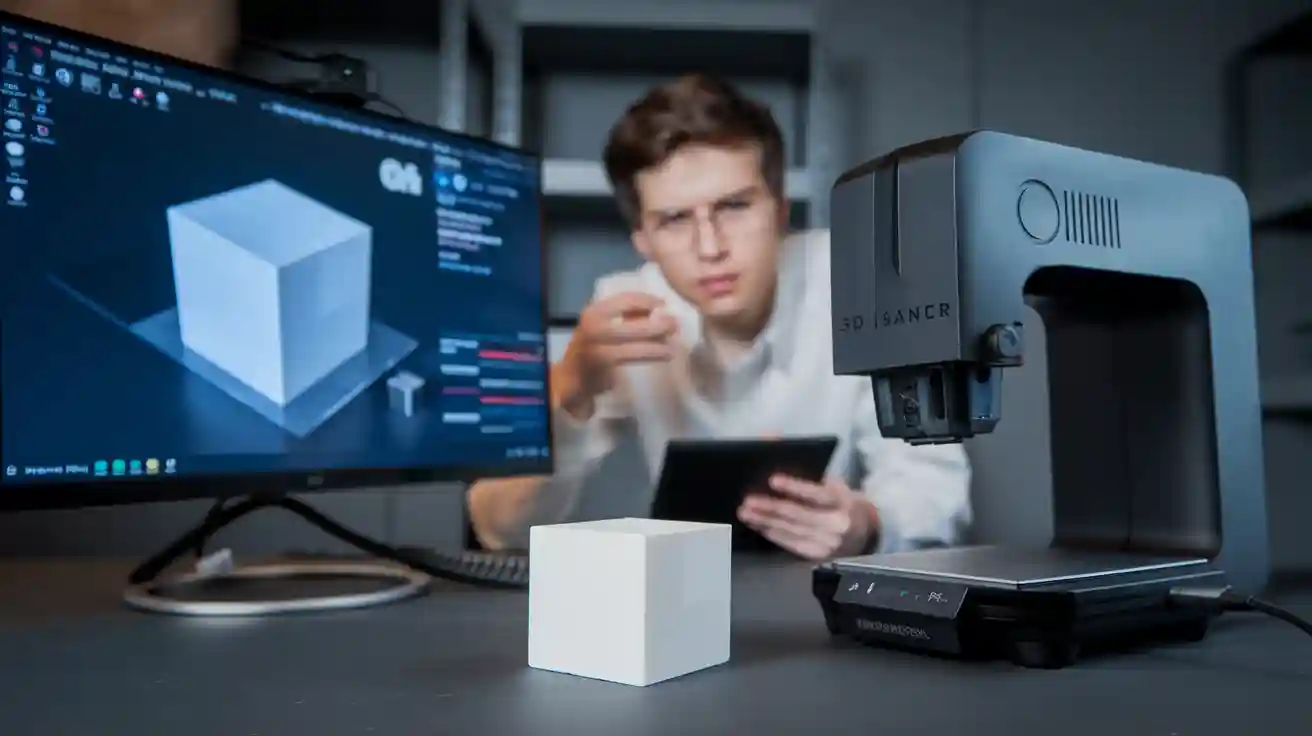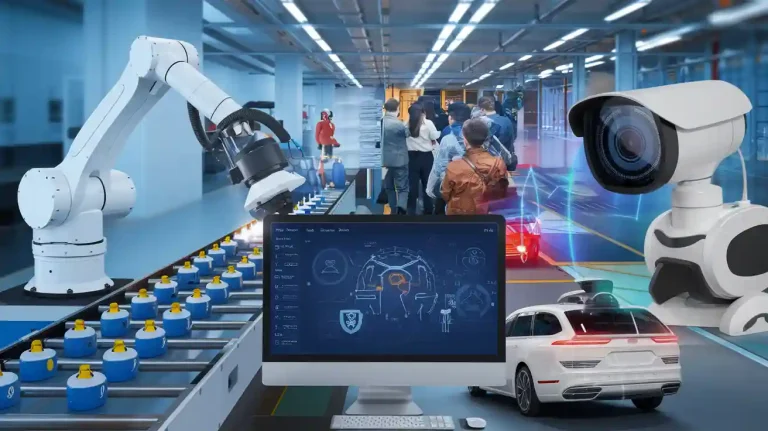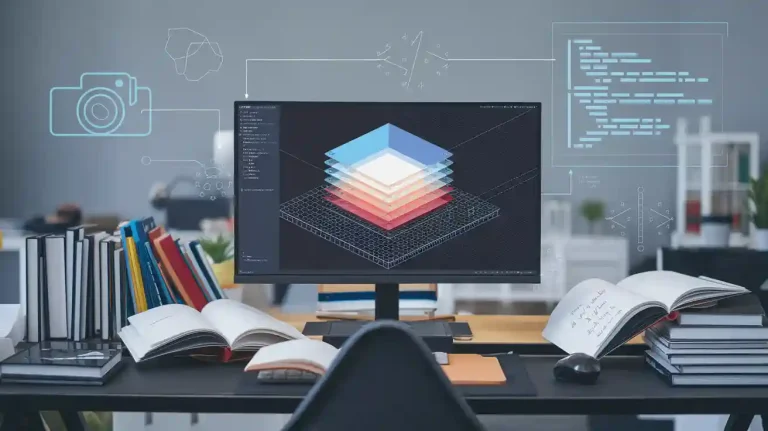
A 3d scan machine vision system helps machines see the world in three dimensions. In factories, workers use 3d scanners to capture shapes and details quickly. These scanners allow robots to measure, inspect, and guide parts with accuracy. 3d vision makes manufacturing smarter and faster. Many industries now rely on 3d scanners and vision for better results. 3d scan machine vision system technology changes how companies solve problems. 3d scanners and vision tools help people find defects and improve safety. 3d vision gives clear images, making work easier. 3d scanners boost productivity. 3d scan machine vision system solutions open new doors for growth.
Key Takeaways
- 3D scan machine vision systems help machines see objects in three dimensions, improving accuracy and automation in industries.
- These systems use parts like structured light, cameras, sensors, and special lighting to capture detailed 3D data.
- 3D vision offers better precision than 2D systems by adding depth, enabling complex inspections and robotic guidance.
- 3D scanners speed up production, find tiny defects, and boost quality control in manufacturing and logistics.
- Beginners should choose the right scanner for their needs, set up carefully, and maintain equipment for best results.
3D Scan Machine Vision System

What Is It
A 3d scan machine vision system helps machines and robots see objects in three dimensions. These systems use 3d scanners to capture the shape, size, and position of items. In factories, workers rely on 3d machine vision systems to inspect products, guide robots, and measure parts. The main function of a 3d scan machine vision system is to collect detailed 3d data that supports automation and quality control. Unlike traditional machine vision systems, which only capture flat images, 3d machine vision systems provide depth information. This extra detail allows machines to understand the world more like humans do.
3d scanners use advanced 3d imaging technologies to create digital models of real objects. These models help companies improve accuracy and reduce errors. 3d scan machine vision systems play a key role in modern manufacturing, robotics, and other industrial fields. They support tasks that require precise measurements and reliable inspection.
Note: 3d scan machine vision systems are not limited to factories. They also help in logistics, packaging, and even medical applications.
Main Components
A 3d scan machine vision system includes several important parts. Each part works together to capture and process 3d data.
- Structured Light: This technology projects patterns onto objects. The system measures how these patterns change to create a 3d map. Structured light does not need extra lighting because it uses its own projector.
- Cameras: 3d machine vision cameras capture images of the object and the projected patterns. High sensitivity, the right spectral range, and fast shutter speeds help cameras collect clear images, even in tough lighting conditions.
- Sensors: Sensors detect the reflected light and help build accurate 3d models. They work with cameras to gather detailed information.
- Lighting: Advanced lighting methods, such as coaxial, dome, diffuse, and dark field lighting, help manage reflections and surface flaws. These methods improve image quality and scan accuracy.
- Ambient Light Suppression (ALS): ALS technology reduces the effect of outside light. This makes 3d scans more reliable and clear.
Different lighting methods suit different surfaces. Coaxial lighting reduces glare on shiny surfaces. Dome lighting gives even light for uneven or glossy items. Diffuse lighting softens shadows and glare. Dark field lighting highlights small defects by shining light at low angles. The camera’s features, such as sensitivity and resolution, affect how much light is needed and how well the system captures fine details.
3D Machine Vision Cameras
3d machine vision cameras are the heart of any 3d scan machine vision system. These cameras come in several types, each with unique features for different industrial uses. The table below shows the most common types of 3d machine vision cameras and their main features:
| Camera Type | Distinguishing Features | Industrial Application Focus | Example Vendors |
|---|---|---|---|
| Time-of-Flight (ToF) | Rapid depth calculation, real-time processing | Robotic guidance, precise 3D positioning | LUCID Helios |
| Stereo Vision Systems | Cost-effective 3D reconstruction in structured environments | 3D reconstruction, cost-sensitive tasks | Basler blaze |
| 3D Cameras | Real-time processing, coordinate accuracy, integration with robotic control | Robotic manipulation, repeatable positioning | LUCID Helios, Basler blaze |
Industrial 3d cameras like Time-of-Flight and stereo vision systems help factories automate tasks that need fast and accurate 3d data. These 3d machine vision cameras support robotic guidance, part inspection, and quality control. They work with 3d scanners and sensors to deliver reliable results.
2D vs. 3D Vision Systems
The main difference between 2D and 3d vision systems is the type of data they collect. 2D systems capture only length and width, while 3d scan machine vision systems add depth. This extra dimension allows for more precise measurements and better analysis of complex shapes. The table below compares the two:
| Aspect | 2D Vision Systems | 3D Vision Systems |
|---|---|---|
| Data Captured | Two dimensions (length and width) | Three dimensions (length, width, and depth/height) |
| Technology Used | CCD or CMOS cameras | Structured light, laser profiling, time-of-flight cameras, LIDAR, stereo vision, photogrammetry |
| Complexity & Cost | Simpler, more affordable | More complex, resource-intensive, higher initial cost |
| Precision & Accuracy | Suitable for surface-level inspections, contrast-based defect detection | Micron-level precision, accurate depth measurement, complex shape analysis |
| Typical Applications | Barcode reading, label verification, defect detection on flat surfaces | Depth measurement, complex shape inspection, robotic guidance, high-precision part inspection |
| Industry Examples | Manufacturing quality control, OCR, surface finish | Automotive weld and gap measurement, electronics solder joint analysis, packaging quality control |
| Limitations | No depth information, sensitive to lighting and shadows | Requires advanced algorithms and sensors, higher setup complexity |
3d scan machine vision systems use 3d scanning technologies to solve problems that 2D systems cannot handle. They help with tasks like robotic picking, complex part inspection, and measuring gaps or welds in automotive production.
How 3D Scanning Works
Scanning Process
3d machine vision systems follow a clear process to capture and use 3d data. First, 3d scanners project light or patterns onto an object. Cameras in the system record how these patterns change on the surface. The scanners collect many images from different angles. The system then uses software to combine these images into a single 3d model. This process allows 3d machine vision to measure shapes, sizes, and positions with high accuracy. Many factories use this process to check parts and guide robots. 3d scanning technologies help companies find defects and improve quality.
Tip: 3d scanners work best when the object stays still during scanning. Movement can cause errors in the 3d model.
Hardware and Software Roles
3d machine vision systems rely on both hardware and software. The hardware includes 3d scanners, cameras, and sensors. These parts collect raw data about the object. The software processes this data and builds a digital 3d model. It also analyzes the model for defects or measurements. 3d vision systems use advanced algorithms to turn images into useful information. The software can highlight problems or send instructions to robots. Good software makes 3d machine vision fast and reliable.
| Hardware | Role in 3d Scanning |
|---|---|
| 3d Scanners | Capture surface details |
| Cameras | Record patterns and images |
| Sensors | Measure depth and position |
3D Scanners
3d scanners are the main tools in 3d machine vision. These scanners come in many types, such as laser scanners and structured light scanners. Laser scanners use a thin beam to scan across the object. Structured light scanners project patterns and watch how they change. Both types help 3d machine vision systems create accurate 3d models. Some scanners work quickly for moving parts. Others focus on high detail for small objects. 3d scanners support many machine vision systems in factories, warehouses, and labs. They help with inspection, sorting, and robot guidance. 3d vision systems depend on the right scanners for each job. Companies choose scanners based on speed, accuracy, and the type of object.
Note: 3d scanners need regular cleaning and calibration to keep 3d machine vision systems working well.
Benefits and Applications
Key Advantages
3d scan machine vision systems offer many benefits for industrial environments. These systems provide high accuracy when measuring parts and products. 3d scanners capture detailed shapes and surfaces, making it easier to find defects during inspection. Companies use 3d vision to speed up production lines and reduce human error. Scanners work quickly, so factories can check more items in less time. This leads to increased efficiency and enhanced productivity. 3d vision systems also help with tasks that need precise measurements, such as blister pack inspection. By using 3d scanners, businesses improve quality control and lower costs.
Tip: 3d scanners can spot tiny flaws that people might miss, helping companies avoid costly mistakes.
Industrial Uses
Many industries rely on 3d scan machine vision systems for daily operations. These systems support manufacturing and logistics by automating complex tasks. The table below shows common industrial applications and real-world examples:
| Industrial Application | Description | Supporting Example/Case Study |
|---|---|---|
| Bin-picking | Automated detection, classification, picking, and placing of objects, improving accuracy especially for small or randomly distributed items. | Pickit’s bin-picking system development case study |
| Depalletization | Automation of removing packages from pallets to increase productivity and speed in repetitive tasks. | Siemens’ automated depalletization solution case study |
| Inspection | Automated quality control to ensure product standards, requiring high-performance 3d vision unaffected by material or environment. | MoviMED robotic inspection for pipe fitting verification |
| Food Automation | Automation in food processing, segmentation, and packing, with high adoption of robotics in packaging. | SIXPAK’s use of 3d color vision to improve food production capabilities |
| Logistics Automation | Automation in freight handling to maintain 24/7 operations with precise tracking and movement, reducing errors. | DHL’s logistics automation using 3d vision and multi-camera calibration technology |
3d scanners help with inspection, sorting, and packaging. They play a key role in manufacturing and logistics by making processes faster and more reliable.
Automation and Robotics
3d scan machine vision systems drive automation in factories and warehouses. Robots use 3d scanners to guide their movements and handle objects safely. These systems allow robots to pick, place, and inspect items with high precision. In manufacturing, 3d vision helps robots assemble parts and check for defects. In logistics, scanners track packages and support automated sorting. 3d vision systems make it possible for robots to work around the clock, boosting productivity and reducing downtime. Companies that use 3d scanners in automation see better results and fewer errors.
Getting Started with 3D
Choosing a System
Selecting the best 3d scanners for a new vision project depends on several factors. Beginners should compare cost, ease of use, and scalability. The table below highlights how common 3d scan machine vision systems stack up:
| 3D Scan System | Cost | Ease of Use | Scalability for Beginners |
|---|---|---|---|
| Photogrammetry | Most affordable | Needs technical skill and time | Scales well but less beginner-friendly |
| Handheld Scanners | Moderate | User-friendly with training | Versatile for many object sizes |
| Desktop Scanners | Higher | Automated and simple to operate | Best for small, detailed objects |
| LiDAR | Expensive | Complex, needs expertise | Suited for large spaces, not for beginners |
Handheld 3d scanners like the KEYENCE WM-6000 offer flexibility and can scan both small tools and large vehicles. Desktop 3d scanners such as the KEYENCE VL Series provide high accuracy and automated features, making them easier for beginners but less portable. Photogrammetry remains the most budget-friendly but requires more technical knowledge. LiDAR systems deliver advanced results but are costly and complex, so they rarely suit beginners.
Tip: Always choose the right 3d machine vision camera for your application. Consider object size, required accuracy, and environment.
Setup Tips
Proper setup ensures 3d scanners and vision systems work well. Place scanners on stable surfaces to avoid movement. Use even lighting to reduce shadows and glare. Calibrate 3d scanners before each use for accurate results. Keep the scanning area clean and free from dust. Connect all vision hardware securely. Install the latest software updates for 3d vision systems. Test the system with sample objects before starting full operations. Train staff to handle 3d scanners and vision software safely.
- Clean scanner lenses regularly.
- Store 3d scanners in a safe, dry place.
- Review manufacturer guides for each vision system.
Common Mistakes
Many beginners make similar errors when using 3d scanners and vision tools. They may skip calibration, leading to poor data. Some ignore lighting, which causes shadows and missed details. Others move objects during scanning, which creates blurry 3d models. Using the wrong 3d scanners for the task can waste time and money. Beginners sometimes forget to update vision software, missing out on new features. They may also overlook safety steps when handling scanners.
Note: Careful planning and regular maintenance help avoid most problems with 3d scanners and vision systems.
3d scan machine vision systems give industries powerful tools for automation and quality control. Scanners capture detailed shapes, while vision software turns this data into clear models. Many companies use 3d vision to improve safety and speed. Scanners help with inspection, sorting, and robot guidance. Vision technology makes work easier for teams in factories and warehouses. Beginners can start with simple 3d scanners and vision software. For more learning, review manufacturer guides or join online forums. 3d vision opens new paths for growth and innovation.
FAQ
What is the main purpose of a 3D scan machine vision system?
A 3D scan machine vision system helps machines see objects in three dimensions. It supports tasks like inspection, measurement, and robotic guidance in industrial settings.
How accurate are 3D scanners in industrial applications?
Most 3D scanners provide high accuracy, often within microns. The exact precision depends on the scanner type, calibration, and the environment where it operates.
Can beginners set up a 3D scan machine vision system easily?
Many modern systems offer user-friendly interfaces and clear instructions. Beginners can start with basic models and follow setup guides to achieve reliable results.
What industries use 3D scan machine vision systems?
Manufacturing, logistics, robotics, and packaging industries use these systems. They help improve quality control, automate processes, and increase productivity.
How does lighting affect 3D scanning results?
Proper lighting reduces shadows and glare, which improves scan quality. Using the right lighting method ensures the vision system captures accurate details.









